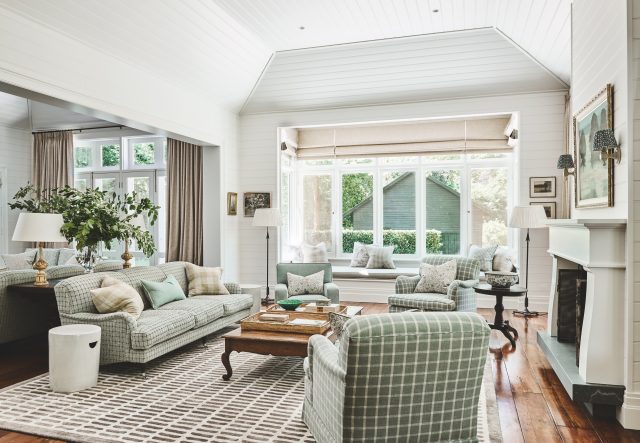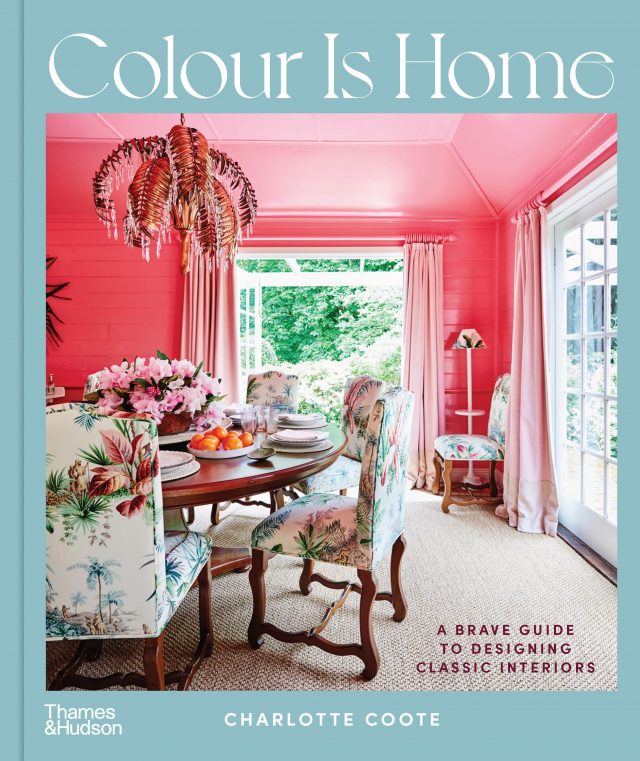The following is an excerpt from Colour Is Home, the new book by Australia-based international interior designer Charlotte Coote.

Rooms designed to enhance conversation, comfort and functionality are, to me, the most successful. In a space that is comfortable and considered, you don’t have to shout to be heard by the person sitting opposite at the dinner table, or get up from your armchair to set down a drink or book.
When deciding how the furniture in a room will be arranged, it is important to consider all the different ways the space could be laid out. Compare the various options, and weigh the problems and advantages of each. Often the best solution will be a combination of one or more of your potential layouts. By following some simple guidelines, the most fitting layout will soon reveal itself.

Creating a Floor Plan
When designing the layout of any room, it is essential to create a scale floor plan. This plan shows the exact dimensions of the room, and the placement and size of each element you will include. If you don’t have the skills to draw up a plan yourself, enlist the help of a designer, draftsperson or architect.
An accurate floor plan will allow you to check your proposed layout for functionality and flow. For example, you can easily measure whether walkways are wide enough, or whether there is ample space for dining chairs to be pushed in and out. A floor plan may need to be revised many times before you arrive at your final layout.

Creating a Great Focal Point
The focal point of your room should be a central item or asset, like a fabulous big rug, a beautiful fireplace, a striking artwork or even a spectacular view. Choose your focal point first, then build the layout of the room around it. Begin by looking at the architecture of the space and then consider which pieces you will use to fill it.

Creating Balance & Symmetry
It is important to create balance and symmetry in your layout. The various pieces of furniture must work together harmoniously. To achieve balance, follow the ‘opposites attract’ principle: combine furniture that is big and small, curved and straight, tall and short, hard and upholstered, old and new, or masculine and feminine.
To create symmetry, place similar or matching pieces opposite each other in the space (try this with chairs, side tables and lamps). The eye should be drawn around the entire room, not to one element in particular. If one piece is standing out too much, it may be an indication that the layout is not balanced. Conversely, if a certain component is getting lost among the scheme, you may need to try rearranging things.

TIPS ON FURNITURE LAYOUT
Below are some of my golden rules for furniture layout. However, remember that in design, as in life, some rules are meant to be broken. If you do decide to break the rules: never complain, and never ever explain.
- Ensure that ample walkways are included in each room and that they are not too narrow. A main thoroughfare through any given room (e.g. between the back of an armchair and the wall) should be a minimum of 80 centimetres (30 inches) wide.
- A big room can often work well with less furniture, while a small room is more appealing when it has lots of furniture.
- Every seat in a room should have a table within arm’s reach.

- All chairs, whether armchair, dining chair, breakfast-bar stool, or sofa, must be inviting and comfortable.
- In living and dining spaces, there should be enough chairs to accommodate the home’s residents, plus additional seating that can be utilised for guests.
- Occasional chairs, which are light and easy to move, are a good option for extra seating. Placed symmetrically around the perimeter of a room, they can be a feature of interest until needed.

- Avoid placing sofas in front of floor-to-ceiling windows, as they will block out too much light.
- Rugs should be positioned at least 40 centimetres (16 inches) away from walls, and away from solid pieces of furniture like television consoles and book cases. Ensure the front legs (at least) of your sofa or armchair stand on the rug.
- Design any built-in joinery joinery – wardrobes, cabinetry and shelving – to be as tall as possible. Not only will this provide more storage space, but it will make the ceiling feel higher by drawing the eye upwards.
- Free standing furniture can be be more interesting and storied than built-in joinery. If you can’t find a piece that is quite the right size, you can make it appear larger by flanking it with a pair of chairs.
- Choose bedside tables that are as large as will fit in the room, to provide plenty of space for lamps, books, reading glasses, cups of tea and vases of flowers.
–Colour Is Home by Charlotte Coote published by Thames & Hudson. $59.99.


The best looking coffee table books: Amy’s top 10

